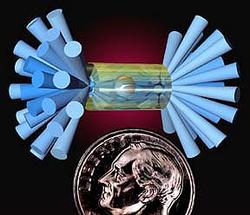Smooth Fusion Lasers

Construction has begun on the $1.2 billion National Ignition Facility (NIF), which will be a major center of U.S. fusion research in the next decade. In experiments there, 192 high-intensity laser beams will briefly blast a target containing a BB-sized capsule filled with deuterium and tritium. The NIF design would improve the homogeneity of heating by surrounding the capsule with a gas-filled “hohlraum,” a small gold cylindrical shell that is directly heated by the lasers and bathes the capsule in the x-ray glow from its extreme temperature. The gas reduces inward movement of the gold hohlraum walls, but it also scatters laser light, reducing the heating efficiency. This fundamental concern among many fusion researchers about the NIF design is addressed by a team in the 30 March PRL, where they present the first detailed measurements of the temperatures and laser scattering in such a system and demonstrate laser techniques that overcome the scattering problems.
As the lasers blast their target, the capsule, gas, and inner hohlraum walls immediately turn to plasma, a hot soup of electrons and ions. Hot spots (imperfections) in the trillion-watt laser beams over-excite the plasma locally, causing it to scatter laser light. Siegfried Glenzer and his colleagues, using a ten laser beam setup at the Nova Laser Facility at the Lawrence Livermore National Laboratory in Livermore, CA, used two methods of “laser smoothing” to reduce the ill effects of hot spots. The first method uses Kinoform phase plates to smooth out larger-scale structures in the beam, as a shower door muddies the view seen through it. The second, called smoothing by spectral dispersion, causes hot spots to move around within the beam, never staying put long enough to significantly over-excite the plasma and create a scattering center. Although these techniques have been available for over a decade, the Livermore team perfected them for use in this type of fusion research.
The Livermore group has also spent several years constructing detector setups to precisely measure the scattered laser light and the temperature within the hohlraum–two critical parameters for tracking their progress toward efficient energy transfer from lasers to target. Their PRL paper represents the first such simultaneous measurements on a gas-filled hohlraum. The data show that the two laser smoothing methods reduced scattering from 18% to 3% and correspondingly increased the temperature inside the hohlraum by about 13 eV to 212 eV (2.5 MK), essentially eliminating the temperature reduction caused by laser scattering. The team also showed that their computer simulation code accurately models many aspects of the heating process, demonstrating its utility for future NIF development work.
The new results resolve one of the lingering fundamental questions regarding the gas-filled hohlraum design for the NIF, according to Robert McCrory, director of the University of Rochester’s Laboratory for Laser Energetics in Rochester, NY. “Unless there are some real surprises,” he says, “we’re running out of things that we’re really worried about.”
More Information
AIP page on the NIF (from September, 1996)


